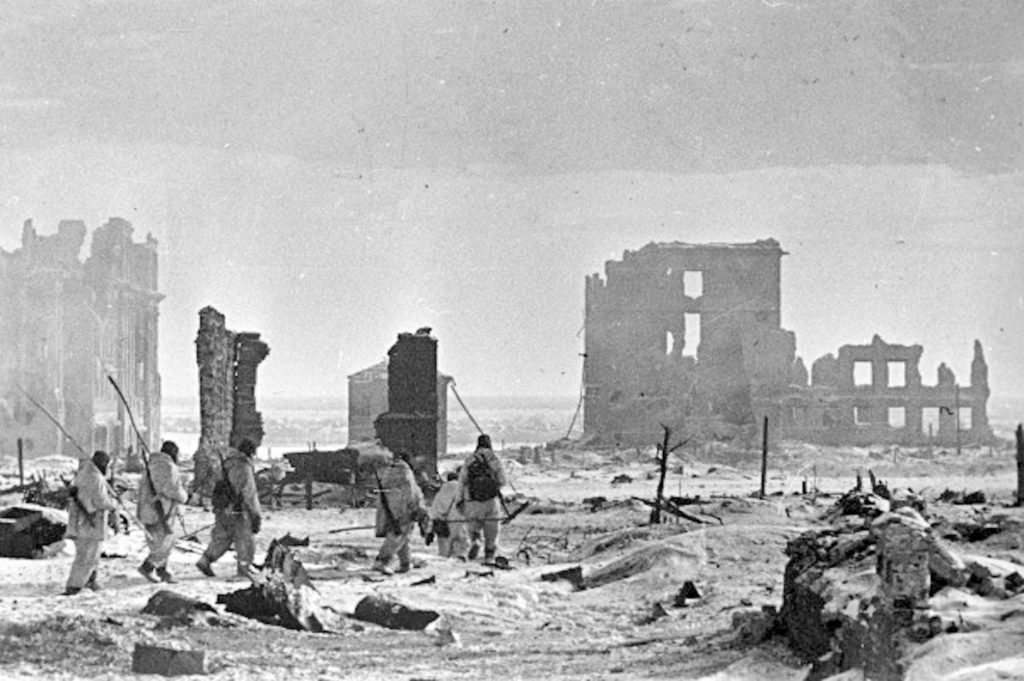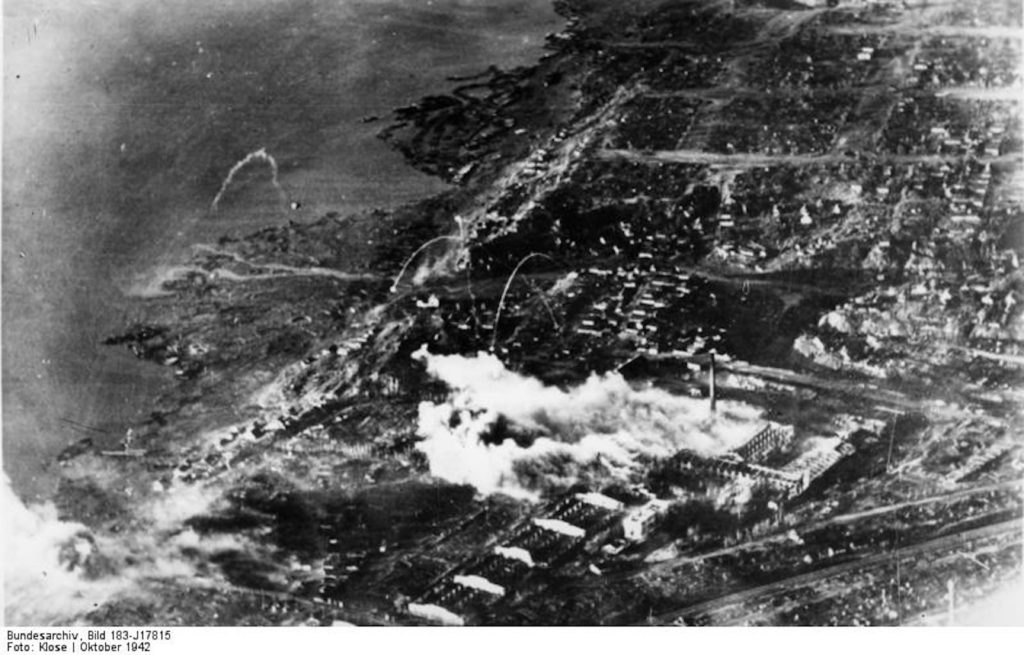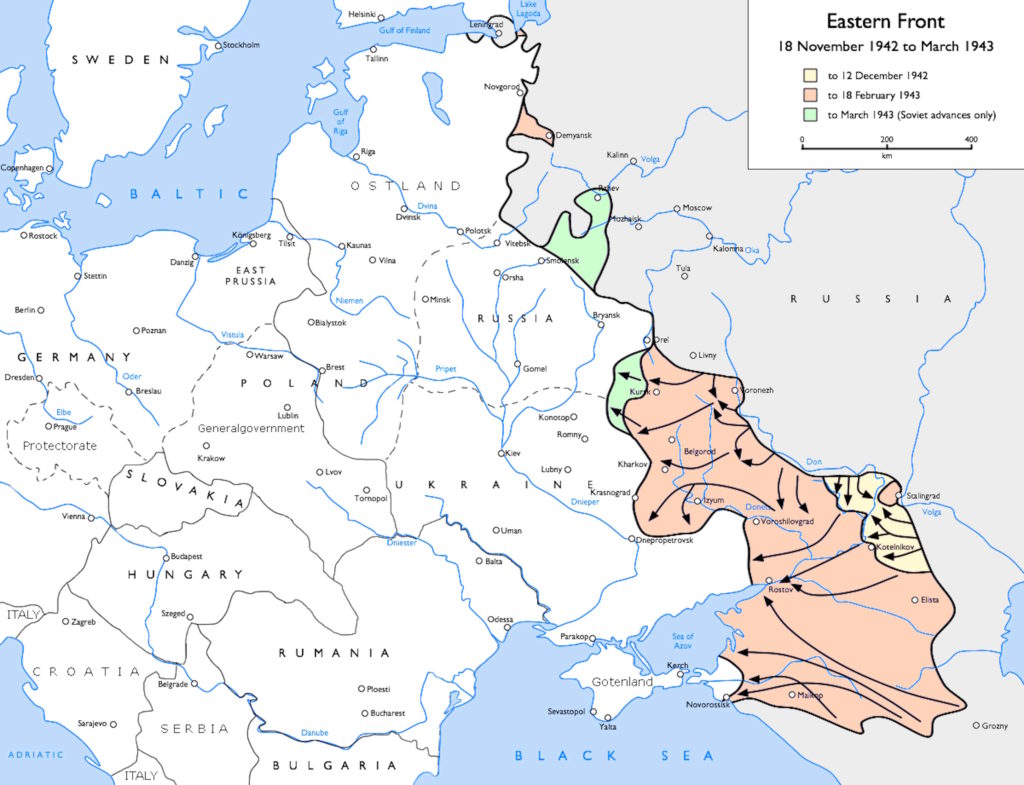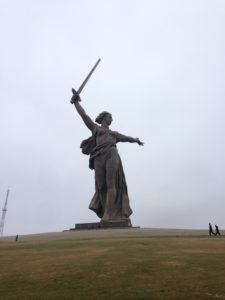The Motherland Calls: The Battle of Stalingrad, 75 Years Later

Editor’s Note: This essay was adapted and expanded from an article published by Origins: Current Events in Historical Perspective.
The most famous battle of World War II began a few days over three quarters of a century ago. More than four million combatants fought in the gargantuan struggle at Stalingrad between the Nazi and Soviet armies. Almost half – over 1.8 million people – became casualties. More Soviet soldiers died in this five-month contest than Americans died in the entire war. But months later, on February 2, 1943, when the Germans trapped in the city surrendered, it was clear that the momentum on the Eastern Front had shifted. The Nazis would never fully recover.
Fourteen months before Stalingrad began, Hitler had launched Operation Barbarossa, the largest military offensive in human history. After two years of decisive victories over France, Poland and others, Hitler and the German High Command were confident that the Soviet Union would fall within six weeks. At first, their prediction seemed correct: The attack in June 1941 caught Stalin unawares and the Red Army unprepared. By December, the Red Army had suffered nearly five million casualties.
But despite enduring staggering losses, the Red Army continued to resist. In August 1941, senior members of the Wehrmacht began growing increasingly uneasy. The Chief of the German High Command staff, Gen. Franz Halder, noted in his diary:
It is becoming ever more apparent that the Russian colossus…. Has been underestimated by us…. At the start of the war we reckoned with about 200 enemy divisions. Now we have already counted 360… When a dozen have been smashed, then the Russian puts up another dozen.
In October, the Wehrmacht launched Operation Typhoon, an effort to take Moscow and end the war by Christmas. But as the weather grew bitterly cold, the German offensive ground to a halt, and was pushed back by a Soviet counteroffensive. The front line froze in place some 200 kilometers west of Moscow – and 1400 kilometers east of Berlin.
During the bitter winter months, the German High Command began planning for a renewed counter-offensive in the spring, hoping to achieve the decisive victory that had evaded them in 1941. Thus Operation Blue was born, an attack to seize the oil fields of the Caucasus and then drive on to the Volga. Launched in June 1942, it caught the Red Army off-guard, as they had expected a renewed push towards Moscow. Within two weeks, the Wehrmacht advanced more than 300 miles.
Hitler, increasingly directing military operations in Berlin, decided to shift his offensive in early August. For both symbolic and strategic reasons, he ordered the Sixth Army under General Friedrich von Paulus to advance towards the city of Stalingrad. By August 23, the Germans were in the suburbs, where fighting turned ferocious. Bombed into rubble by German aircraft and artillery, the city became impassable to tanks and an ideal terrain for defenders.
As the Germans approached Stalingrad, Stalin issued Order No. 227, with its famous command: “Ni shagu nazad!”, or “Not one step backwards!” This meant a horrific price for the Soviet defenders within the city of Stalingrad. Outnumbered and without air cover, the 62nd and 64th Soviet Armies suffered enormous losses: For example, the 13th Guards Division, entering the battle with over 10,000 men, suffered 80 percent casualties in its first week in the city alone.

In September, Stalin sent General Vasily Chuikov to take command of the embattled survivors of the 62nd Army in the city itself. They were tenaciously clinging to rubble on the west bank of the Volga, with only a few hundred meters between its front lines and the river to its back.
Chuikov recalled the grim moment:
When I got to army headquarters I was in a vile mood. Three of my deputies had fled … But the main thing was that we had no dependable combat units, and we needed to hold out for three or four days … We immediately began to take the harshest possible actions against cowardice. On the 14th I shot the commander and commissar of one regiment, and a short while later, I shot two brigade commanders and their commissars. This caught everyone off guard. We made sure news of this got to the men.
Despite his brutality, Chuikov earned the respect of his soldiers, taking the same risks they did. He was buried alive several times by German bombardments and kept his headquarters in the city, less than 200 meters from the German front line. In the face of ferocious Soviet resistance, the Germans poured more and more men into the battle at Hitler’s command. By November, the German High Command had committed 1.2 million men, or about half of its strength facing the Red Army, to the southern front.
As the fighting reached its fevered peak in the city itself, Gen. Alexander Vasilevsky and Gen. Georgy Zhukov at Stavka (the Red Army High Command) came up with a master stroke to counter the enormous pressure on the city. They proposed a massive double encirclement of the entire German Sixth Army. Stalin approved their plan – Operation Uranus – on November 13.
Over a million Soviet soldiers struck on the snowy, foggy morning of November 19. They drove into the weakly guarded flanks of the German Sixth Army. Within four days, they had encircled 300,000 Axis soldiers, trapped in a frozen wasteland in and around Stalingrad. German attempts to break into the pocket failed. Over the next three months, the Red Army began to squeeze the life out of them. Efforts at supplying the surrounded troops in the pocket) via air proved beyond the Luftwaffe’s declining capabilities.

By December, when German airlifts ceased, life in the surrounded ruins became a living hell. As one German soldier recalled: “We were so weak and exhausted and there were so many dead lying around in the open frozen stiff, that we could not bury our own comrades.” As rations reached zero, sentries froze to death on guard duty. A typhus epidemic ravaged the survivors. Medical treatment proved impossible; the badly wounded or sick were left outside to freeze to death, as a “mercy” to the longer death from starvation or infection. Rumors of cannibalism grew increasingly frequent.
As conditions became unbearable, Hitler ordered his men to fight to the last. In an effort to encourage his commanding general, he made Paulus a field marshal on January 30. As no German field marshal had ever surrendered, Hitler hoped Paulus would kill himself rather than be captured. Instead, on January 31, 1943, Paulus surrendered the 91,000 skeletal German soldiers still left under his command; some would fight on until February 2. Only 6 percent would survive Soviet captivity.
The Germans would launch one more major offensive on the Eastern Front – Kursk – in July 1943, but it failed. Stalingrad marked the shift of initiative to the Red Army on the Eastern Front. There were no more decisive victories for the Wehrmacht in the east. Despite the importance of the battles of Moscow, Kursk, and Operation Bagration, it was Stalingrad that would be immortalized around the world as the turning of the tide for the Allies in World War II.
Three quarters of a century later, Stalingrad – and the war more generally – are still shaping Russian foreign and domestic policy. 86 percent of Russians still view the Great Patriotic War – as it is known in the Russian Federation – as the most important event in the “history of their country.” Given that one in six Soviet citizens died in the war, its place in the country’s historical consciousness is understandable. But that sacrifice has made discussion of the war dangerous ground for historians, journalists, and the public: A televised discussion on January 26, 2014 on the Dozhd network about Soviet mismanagement of the siege of Leningrad caused that network to be effectively shut down, lose all its syndication rights, and be forced to move its studio. The Director of the Russian State Archive Sergei Mironenko was fired in 2016 for debunking a famous Soviet wartime story. And historians now face prison sentences for “criticizing the Red Army.”
For President Vladimir Putin, the war remains personal. Putin’s older brother, whom he never met, died during the Siege of Leningrad. His father was maimed in the war. Much of his extended family died in the conflict. Putin himself has repeatedly attended the wreath-laying ceremony at Stalingrad’s central monument to the battle at Mamaev Kurgan. In 2014, he also said he favored a referendum to consider renaming the city Stalingrad. He has also used the historical memory of the war to shore up his own base of power and to justify his foreign policy worldview.
Sarmite Elerte, the former Latvian minister of culture, described the role of the war in Russian policymaking thus:
The myth of the Great Patriotic War serves to galvanize its [Russia’s] people … It is a means of reaffirming the unity of the people and the leader … In foreign policy, the myth is a message to the world that … Russia has a right to zones of influence. It is a means of disseminating and preserving Soviet identity across borders, as well as an instrument of dividing societies in countries neighbouring Russia.
The twin pillars of Soviet suffering and Stalinist success in beating Hitler are used to justify Russian intervention in Russia’s borderlands. The former justifies Russian involvement in neighboring states. The latter is used to buttress a new, neo-Stalinist worldview of unfettered great power competition, competing over zones of influence, with small states having little real sovereignty.
As Russia finds itself internationally isolated, the story of World War II has become ever more central in Russian foreign policy. Unsurprisingly, Stalin’s standing has risen markedly among Russians as Russia’s own geopolitical stance has become increasingly aggressive. In 2012, 25 percent of Russians agreed with the statement that “the repressions [of Stalinism] were justified by the modernization of the country.” By early 2015, after the invasion of Crimea, that number had risen to 46 percent.
Telling the story of the battle of Stalingrad fully would help to undercut the dangerous version of the war’s myths. It may come as a surprise, for instance, that 75 years later, that parts of the story of Stalingrad remain cloaked in myth. Anthony Beevor’s magisterial 1999 work is the best history of the battle, but depends far too much on German sources. That is hardly his fault: The Soviet, and now Russian, archives often remain inaccessible. That is a double tragedy, as there is no reason for that to be the case. The tremendous wealth of interviews, journals, diaries, and official documents that could paint the story from the Soviet side in all its rich colors have been hidden.
During the war, a team of Soviet historians established the Commission on the History of the Great Patriotic War. Its job was to interview thousands of soldiers as the war went on, with the hopes of publishing them upon final victory. But their stories did not suit the Soviet state after 1945. The commission’s members faced arrest or termination from their jobs. Their work was suppressed or destroyed. It was a monumental accomplishment that some of the portions from the Battle of Stalingrad finally appeared in print in 2012, thanks to a partnership between the Russian Academy of Sciences and the German Historical Institute in Moscow, led by Rutgers historian Jochen Hellbeck. The story those interviews tell is one of heroism, dedication, and staggering self-sacrifice, but they also recount hunger, devastation, and mismanagement by the political and military authorities. That was the real story of the war; it does not resemble the war shown in new state propaganda films like Panfilov’s “28 Men.”

The myth of Stalin’s success – which seems to underpin Putin’s newly revanchist foreign policy – needs to be ended. There is no one else who can do that besides Russian and Western historians. Stalin was not the savior of the Russian people. Rather, he was nearly the author of their demise, responsible for untold millions of deaths during the war itself. Stalin enabled Hitler by secretly assisting in the rearmament of the German state between 1926 and 1941. He partnered with Hitler in partitioning Eastern Europe in the Molotov-Ribbentrop Pact. He provided Hitler with two million tons of oil and staggering quantities of natural resources which fed the German war machine as it overran Denmark, Norway, the Netherlands, Belgium, France, Yugoslavia, and Greece. He even provided a naval base on Soviet soil for the German Kriegsmarine to raid Allied shipping.
At home, Stalin made the Soviet Union’s predicament worse by murdering or arresting his best officers immediately prior to the war. His personal arrogance and poor decision-making led to the staggering disaster of the first year of the campaign, with its five million Soviet military casualties. During the war, his personal refusal to allow the evacuation of civilians in Stalingrad and Leningrad probably cost 1.5 million Russian civilians their lives. Up to 5.5 million Soviet citizens were killed by the state as part of political repression campaigns during the war. Stalin enabled the war and then maximized the cost his people would pay for victory. That knowledge should undermine any notions that some sort of neo-Stalinist foreign policy is a way forward for Russia today.
Revisiting the war will be difficult. Nearly every Russian family was affected by the conflict. Acknowledging the problematic nature of the Soviet regime and its inhuman brutality towards its own people is traumatic. That is why myth-making under Putin has had such potency. Realistically, it may not be possible to evaluate Russia’s war effort with fresh eyes until the last veterans of the war have passed on. But truly honoring the 27 million Soviet citizens who died and building a better future for their descendants will require some soul searching, and some new histories.
The heights of Mamaev Kurgan are crowned with what was once the world’s tallest free-standing statue: a woman, symbolizing Mother Russia, pointing with a sword towards Berlin. It is entitled “The Motherland Calls,” the evocative call-to-arms in defense of Russian homes. Perhaps now, her cry should be rewritten: now, the motherland calls for truth, and honest remembrance.
Ian Johnson is the Associate Director of the Brady-Johnson Program in Grand Strategy at Yale University, where he also teaches in the Department of History. In 2016, he completed his Ph.D. in history at the Ohio State University with a dissertation that explored secret military cooperation between the Soviet Union and Germany in the interwar period. He is the editor of a forthcoming book, The White Nights: Pages from a Russian Doctor’s Notebook (Bowen Press Books, 2017), and author of the soon-to-be released The Faustian Bargain: Secret Soviet-German Military Cooperation in the Interwar Period (Oxford University Press, 2018).
Image: RIA Novosti archive, Image #602161 / Zelma / CC-BY-SA 3.0, via Wikimedia Commons

